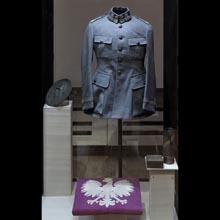
1. Tunic of Marshal Józef PiłsudskiModel 1919
Poland, Warsaw, workshop of Spinka
2. Round plate with bust of Marshal Józef Piłsudski
Poland, made by E. Korosadowicz, about 1934
From the collections of the former Industrial Museum in Krakow
3. Pillow for coffin of Marshal Józef Piłsudski
Poland, made by the Institute of Handicraft Improvement in Krakow, May 1935
This pillow was to be put into the coffin of Marshal Piłsudski, but it turned out to be too large and therefore it was donated for the collection of the Industrial Museum in Krakow
4. Urn
Poland, made by Rifle Club of Ropczyce district, about 1915-1918
The urn is inscribed with dedication: „Związek Strzelecki / Powiat Ropczyński / Ziemia / Z Grobu Śp. Ppo Leg. St. Króla Koszubskiego Straconego Przez / Moskali W Pilźnie W Roku 1915” (“Rifle Club / Ropczyce district / soil / from the grave of the late legions second lieutenant St. Król Koszubski executed by / Russians in Pilzno in 1915”)
5. Urn
Poland, made by the 10th Mounted Rifle Regiment from Łańcut, 1935
The urn was made of Austrian cannon shell, model 1875, calibre 70 mm.
Urn is inscribed with dedication: „W Hołdzie Marszałkowi Józefowi Piłsudskiemu / Dnia 11 VI 1935 Wycieczka 10. P. Strzelców Konnych / Składa Ziemię Łańcucką W Pocisku Z Walk Nad Rz. Bugiem” (“In tribute to Marshal Józef Piłsudski / 11 VI 1935, the 10th Mounted Rifle Regiment participants of an excursion / placed the Łańcut’s soil in the shell from the battlefield on the Bug River”)
exposition: Gallery „Arms and Uniforms in Poland",
The Main Building, 1, 3 Maja Av.
key: Military and civilian uniform <<<
The collection of 18th- to 20th-century uniforms and accessories belonging to the National Museum in Krakow, the second largest in size and scope in Poland, contains unique examples of Polish uniforms from the 18th and 19th centuries. The oldest uniform element from the Polish military in the collection is the grenadier cap from the Lithuanian Foot Guards Regiment from 1732. The museum is in also in possession of the only preserved General’s uniform from the National Cavalry from the 18th century, which belonged to Benedict Kołyszka. Uniforms of the nineteenth century are represented by the army general’s uniform of Franciszek Paszkowski, who was also the owner of Varsovian Duke Fredyryk August’s chamberlain’s uniform. No less interesting is the officer’s uniform of the light cavalry of the Imperial Guards of Emperor Napoleon I, as is the officer’s uniform from the Second Uhlan Regiment of the Congress Kingdom of Poland. Also from that period are a large number of uniform jackets, caps and flat caps, epaulettes, gorgets, ammunition pouches, and other items. A unique item which attracts little attention is a pair of high boots from the Congress Kingdom period with shoe trees belonging to the unform of an cavalry adjutant general and a pair of epualettes from 1831 from a horse cavalry officer’s uniform belonging to Konstanty Ordon, the hero imortalised in Adam Mickiewicz’s poem Ordon’s Redoubt (Reduta Ordona).
In addition to Polish uniforms, the collection contains nineteenth-century military uniforms and effects from other European countries: France, Prussia, Russia, Austria and the Vatican. Standing out among them are a complete French female sutler uniform from the Third Empire period and a dolman belonging to Henryk Dembiński, commander-in-chief of the Hungarian uprising in 1849.
A separate group is made up of Polish and European civilian uniforms with unique dress coats of the Senators of the Congress Kingdom of Poland, the authorities of the Free City of Krakow, the diplomatic service of Austria and Poland, and the uniform of a Knight of Malta from the 1920s.
The twentieth-century uniform collection is somewhat more modest, but also contains some very rare items, such as hats and jackets of the Uhlan regiments of the Polish Legions, elements of uniforms from the Polish-Bolshevik war, the two decades of the interwar period, and a collection of designs for military ranks for collars and epaulettes for the First and Second Brigades of the Polish Legions and the Armed Forces of the Polish Republic from 1914-1917. This is the only set of its kind preserved in a Polish museum, constituting an immeasurably important historical source regarding those units, received as a gift from the Supreme National Committee in 1920. The collection is continued with uniforms from the period of the Second World War and the post-war period, as well as post-war uniforms used until the end of the twentieth century.
Piotr Wilkosz












